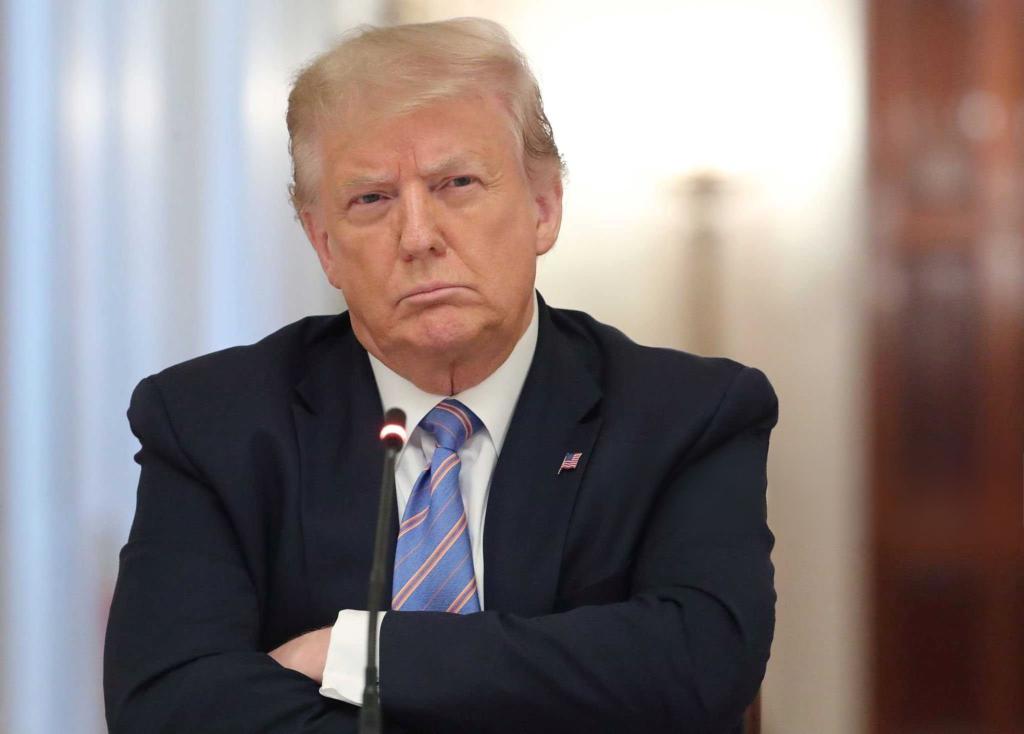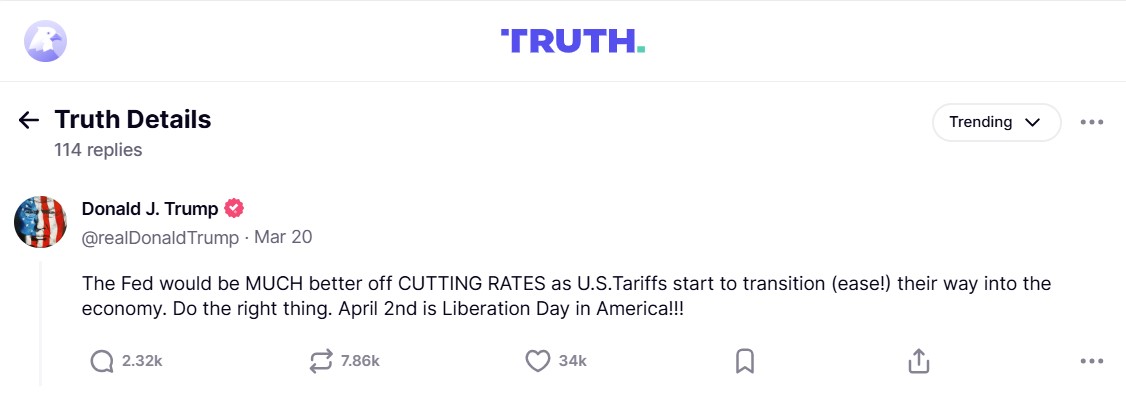
Daily Market Analysis and Forex News
“Liberation Day”: How markets might react to Trump’s April 2nd tariff announcement?

- Trump set to announce “reciprocal” tariffs on Wednesday, April 2nd.
- Markets fear worst-case scenario: average US tariff hiked to 35%
- Higher tariffs may lead to US stagflation: revived inflation, slower economic growth
- Tariff shocker could see US dollar and stock indexes fall, gold soars
- Less-than-feared tariffs could see US dollar and stocks rebound
This Wednesday, US President Donald Trump is set to upend global trade with “reciprocal” tariffs.
Here we break down what traders and investors need to know ahead of such a pivotal announcement.
When will Trump announce “reciprocal” tariffs?
President Trump is set to announce his next batch of tariffs on Wednesday, April 2nd at 4:00 PM EST / 8:00PM GMT.
POTUS has even labelled April 2nd as “Liberation Day” in a social media post on March 20th:
Imagen
What do “reciprocal” tariffs mean?
As the word suggests, the US is likely looking to charge its trade partners the same tariffs as they charge the US.
This suggests “an eye for an eye” type of approach.
However, it may not be that straightforward.
When deciding the revised % tax rate to “reciprocate” with, the US administration may also incorporate the cost of non-tariff barriers, such as:
- regulations
- other taxes such as VAT charged domestically in other countries
- even currency exchange (forex/FX rates)
In other words, it’s hard to predict what the final % number will be, prior to the April 2nd announcement.
Wait, hasn’t Trump already announced tariffs this year?
Yes.
Since his second inauguration on January 20th, 2025, President Trump has imposed:
- 20% tax on all Chinese goods (10% in February, doubled in March)
- 25% tax on most imports from Canada and Mexico (delayed until April)
- 25% tax on steel and aluminum (imposed on March 12th)
- 25% tax on auto imports (starting on April 3rd with fully assembled imported vehicles; scope of taxable goods to be expanded in early May)
But the April 2nd announcement is the next “big one”, with potentially larger and broader tariffs to be announced.
Hence, the palpable tensions leading up to this mid-week announcement.
Markets have been especially volatile in recent weeks, with traders and investors guessing what Trump’s next tariff salvo would actually entail.
Even the S&P 500 dipped into a "technical correction", TWICE, in March 2025!
Why is Trump doing this?
As a overall goal, Trump is looking to “fix” the trade imbalances between the US and its trading partners.
With these tariffs, Trump intends to:
- revive manufacturing jobs in the US
- raising revenue for the government
- align the policies of foreign governments with his administration’s goals
Who might be targeted?
In short, it's not yet clear.
We know that President Trump has often targeted major trading partners, including China, the EU, Canada and Mexico.
However, recent weeks have seen various government officials, including Trump himself, use varying terms to describe which countries are set to be on the receiving end of these "reciprocal tariffs".
These include phrases like "all countries", to "country-specific", to "15% of all countries", and even "dirty 15".
Just for context, it’s estimated that 15 countries accounted for over 75% of all US imports in 2024.
This “dirty 15” list may include:
- China
- Mexico
- Vietnam
- Ireland
- Germany
- Taiwan
- Japan
- South Korea
- Canada
- India
- Thailand
- Italy
- Switzerland
- Malaysia
- Indonesia
What’s the worst-case scenario?
As a catch-all headline number …
Bloomberg economists predict that the “maximum” damage could raise the average US tariff to 35%!
That would be 28 percentage points higher from the mid-single digit average at present (as of March 2025, after taking into account the already-imposed tariffs so far in Trump's second term as POTUS).
For reference, when President Trump kicked off his second term, the average US tariff rate was around 2.5%.
Why are markets concerned?
Overall, Trump’s next tariff salvo may well be the most protectionist move by the US government in about a century (since the Smoot-Hawley Tariff Act of 1930)!
Higher US tariffs could actually reignite US inflation, while slowing down its economic growth.
According to a model by the Federal Reserve, US GDP could be negatively impacted by 4%, while lifting inflation by 2.5% over the next 2-3 years.
This points to a "stagflation"!
Furthermore, a slowdown in the world's largest economy is bound to weigh down the global economy in tandem.
But wait, there could be more tariffs ahead!
White House Press Secretary Karoline Leavitt said on March 31st that President Trump may look to also impose sector-specific duties further down the line.
These could impact imports of:
- copper
- pharmaceuticals
- semiconductors
- lumber
However, these sectoral duties are apparently not the main focus on April 2nd.
How might markets react to the April 2nd announcement?
- If Trump confirms the market’s "worst case" scenario, we could see:
- US assets FALLING (e.g. US500, US30, NAS100, US dollar etc.)
This would be based on the notion that US economic growth will be impacted negatively from these hiked tariffs.
- Safe havens SOAR (e.g. gold, Japanese Yen, Swiss Franc) and even potential gains for some non-USD currencies (such as the British Pound, with the UK seemingly not front-and-center in Trump’s tariff cross-hairs)
- However, if President Trump’s “reciprocal” tariffs package prove to be not-as-bad-as-feared, that could see:
- US assets REBOUND (e.g. US500, US30, NAS100, US dollar etc.)
This would be based on the notion that the tariffs’ impact on US economic growth would be less severe.
- Safe havens DIP (e.g. gold, Japanese Yen, Swiss Franc) and even potential declines for some non-USD currencies (such as the British Pound) which have climbed as money flowed away from the US dollar in recent weeks.
Although uncertainty is running high leading up to the announcement, one thing is for sure ...
Wednesday, April 2nd 2025 is set to be a big day for governments, businesses, investors, and traders around the world.
Ready to trade with real money?
Open accountChoose your account
Start trading with a leading broker that gives you more.
